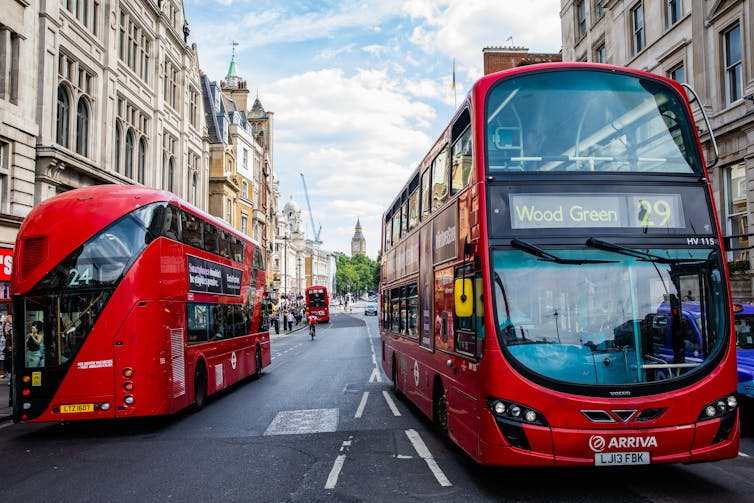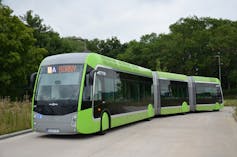Why the humble city bus is the key to improving US public transit
High-quality bus service is the fastest route to rapid, comprehensive public transit in the United States. This country was once a leader in bus transit, and with adequate funding, it could be again.

Public transit in the U.S. is in a sorry state – aging, underfunded and losing riders, especially since the COVID-19 pandemic. Many proposed solutions focus on new technologies, like self-driving cars and flying taxis. But as a researcher in urban policy and planning, I see more near-term promise in a mode that’s been around for a century: the city bus.
Today, buses in many parts of the U.S. are old and don’t run often enough or serve all the places where people need to go. But this doesn’t reflect the bus’s true capability. Instead, as I see it, it’s the result of cities, states and federal leaders failing to subsidize a quality public service.
As I show in my new book, “The Great American Transit Disaster: A Century of Austerity, Auto-Centric Planning, and White Flight,” few U.S. politicians have focused on bus riders’ experiences over the past half-century. And many executives have lavished precious federal capital dollars on building new light, rapid and commuter rail lines, in hope of attracting suburban riders back to city centers and mass transit.
This was never a great strategy to begin with, and the pandemic-era flight of knowledge workers to home offices and hybrid schedules has left little to show for decades of rail-centric efforts. Meanwhile, countries in Europe and Latin America have out-innovated the U.S. in providing quality bus service.
But it doesn’t have to be this way. Many U.S. cities are coming around to the idea that buses are the future of public transit and are working to make that vision real. And the Bipartisan Infrastructure Law enacted in 2021 is providing billions of dollars for new buses and related facilities.
Buses as disruptors
A century ago, motorized buses were the technological wonder of their day. Rolling fast on tires over newly paved streets, buses upended urban rail transit by freeing riders from aging, crowded, screeching streetcars. In 1922, American buses carried 404 million passengers; by 1930, they were carrying 2.5 billion yearly.
At that time, transit lines were mostly privately owned. But this model was failing as riders became car drivers, new zoning laws prioritized car-friendly single-family housing and government regulators battled transit companies over fares and taxes.
Transit executives trying to eke out a profit saw buses as a way to reduce spending on track maintenance and labor costs for “two man” operated streetcars. City leaders and planners also embraced buses, which helped them justify removing streetcar tracks to make streets more navigable for cars. From the 1920s through the 1960s, nearly all U.S. streetcar lines were replaced with buses powered by either internal combustion engines or electric overhead wires.

This wasn’t just a U.S. trend. Toronto massively extended bus service across a vast metropolitan area between 1954 and 1974, using buses to feed suburban riders to a new subway system and a few remaining streetcar lines. By 1952, London’s managers had replaced streetcars with the city’s signature fleet of double-decker buses, which complemented its legendary Underground service.
Across Europe, cities relied on buses to support and complement their modernizing tram or subway networks. Political leaders provided deep subsidies to deliver better bus and rail service.
The auto-centric US path
In the U.S., however, federal investments in the same time frame focused on building a national highway system to serve private automobiles. Lacking tax subsidies, bus networks could not compete with cheap cars and government-funded highways. Aging buses and infrequent service became the default postwar reality – and those buses had to travel on local streets crowded with private cars.
Between 1945 and 1960, U.S. transit companies and agencies typically lost half or more of their riders as white Americans moved to urban fringes or suburbs and became car commuters. Bus service remained concentrated in older, central-city neighborhoods, serving a disproportionately nonwhite, low-income ridership.
Many public systems had to cut bus service year after year to balance their books. Only a few cities that were willing to provide significant operating subsidies, including San Francisco and Boston, were able to maintain better bus networks and some trolleybuses.
New, better buses
Today, there’s renewed interest in improving bus service in the U.S., inspired by innovations around the globe. The Brazilian city of Curitiba, which is well known for its innovations in urban planning, set a model in the 1970s when it adopted bus rapid transit – buses that run in dedicated lanes, with streamlined boarding systems and priority at traffic signals.
Curitiba helped popularize bi-articulated buses, which are extra-long with flexible connectors that let the buses bend around corners. These buses, which can carry large numbers of passengers, now are in wide use in Europe, Latin America and Asia.

Cities across the globe, led by London, have also aggressively expanded contactless payment systems, which speed up the boarding process. Advanced bus systems and new technologies like these flourish in regions where politicians strongly support transit as a public service.
In my view, buses are the most likely option for substantially expanding public transit ridership in the U.S. Millions of Americans need affordable public mobility for work, study, recreation and shopping. Car ownership is a financial burden that can be as serious for low-income families as the shortage of affordable housing.
The average yearly cost for U.S. households to own and operate a new car reached US$10,728 in 2022. Nor are used cars the bargain they once were. Used car prices are high, financing is often subprime and older vehicles require expensive maintenance.
Rapidly extending bus networks would be the speediest and most economical way to serve these families and grow transit ridership in the sprawling landscape of American metros. U.S. roads and highways are already maintained by the government, eliminating the need to build and maintain expensive rail lines.
There are promising domestic models even amid the pandemic ridership crisis. In the past two decades, Seattle’s Sound Transit has upgraded its bus network, aligning these improvements with increased residential density, low fares and a carefully considered light rail expansion. San Francisco and New York have developed exclusive bus lanes that move riders along popular routes at higher speeds. Indianapolis is expanding an effective bus rapid transit system. Many cities, including Denver and Boston, are investing in “better bus” upgrades that emphasize frequent service, easy transfers and better geographic coverage.
Innovations like these will only succeed long term with sufficient subsidies to maintain innovative services at reliable levels. The history of bus transit is littered with pilot programs that were abandoned on cost grounds just as they were gaining popularity. As I see it, buses don’t need to be faster or more convenient than cars to attract and retain riders – but they need to be, and can be, much better transit options than they are today.
Nicholas Dagen Bloom does not work for, consult, own shares in or receive funding from any company or organisation that would benefit from this article, and has disclosed no relevant affiliations beyond their academic appointment.
Read These Next
How the ‘slayer rule’ might play a role in determining who will inherit wealth from Rob Reiner and h
These rules have a long history in the United States. They played a role in the notorious murders by…
From truce in the trenches to cocktails at the consulate: How Christmas diplomacy seeks to exploit s
World leaders like to talk up peace at Christmastime. But alongside the tales of seasonal breaks in…
As DOJ begins to release Epstein files, his many victims deserve more attention than the powerful me
Powerful men connected to Jeffrey Epstein are named, dissected and speculated about. The survivors,…






